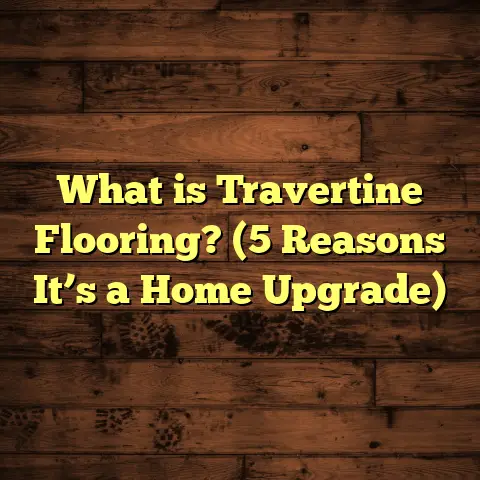What is Tile Flooring? (5 Benefits of Durable Design)
Facing the Flooring Dilemma: Why Tile Flooring?
I vividly recall that moment when I was helping a close friend renovate her kitchen. We were standing in the middle of the empty room, staring at the bare subfloor, and the big question hit us: “What flooring should we choose?” It might sound simple, but anyone who has faced this choice knows it’s anything but. There are so many options—hardwood, laminate, vinyl, carpet, tile—and each has its own set of pros and cons. My friend wanted something durable yet stylish, easy to maintain but also comfortable underfoot. And let’s be real—she didn’t want to spend an arm and a leg.
I’ve been in the flooring business for years, and this kind of dilemma shows up all the time. After weighing many options, tile flooring stood out as a solid choice. But what exactly is tile flooring? Why does it keep popping up as a top recommendation for kitchens, bathrooms, and high-traffic areas?
I want to share my thoughts and experiences about tile flooring from a hands-on perspective. I’ll explain what it is, why it’s so popular, and why I personally recommend it for many projects. Plus, I’ll break down five key benefits of tile’s durable design that you might not have considered. Spoiler: it’s not just about looks or durability—it’s about smart long-term choices that save you headaches down the road.
What Is Tile Flooring?
Let’s start with the basics: what is tile flooring?
Tile flooring consists of individual pieces—called tiles—made from different materials like ceramic, porcelain, natural stone (such as marble or slate), glass, or even metal. These tiles are laid side by side to cover a floor surface.
Tiles come in various sizes (from tiny mosaics to large slabs), shapes (square, rectangular, hexagonal), colors, and finishes (matte, glossy, textured). They are usually set into a bed of mortar or adhesive and separated by grout lines. The grout fills gaps between tiles to secure them and prevent dirt or moisture from seeping underneath.
Ceramic tiles are made from clay that’s been fired at high temperatures and coated with a glaze. Porcelain tiles are a type of ceramic but denser and fired at even higher temperatures. This makes porcelain tougher and less porous than regular ceramic.
Natural stone tiles come straight from quarries and are cut and polished for floors. Each stone tile is unique due to natural veining and color variations.
From ancient Roman mosaics to modern minimalist designs, tile flooring has a long history spanning thousands of years. I find it amazing that this simple concept—small pieces arranged in patterns—has stayed relevant for so long because it works so well.
5 Benefits of Durable Tile Flooring Design
I’ve installed hundreds of tile floors over the years in homes, restaurants, offices—you name it. If there’s one thing I can tell you with confidence, it’s that tile floors are built to last and deliver value beyond initial impressions.
Here are five major benefits of choosing tile flooring with durable design in mind:
1. Durability That Lasts Decades
Durability is probably tile’s biggest selling point. Porcelain tile specifically boasts water absorption rates below 0.5%, which means it barely soaks up moisture at all. Ceramic tiles vary but usually absorb less than 3%.
This low porosity means tiles can withstand spills, humidity, and temperature changes without damage. Unlike hardwood floors which can warp or laminate floors that can peel or swell when wet, tile holds strong.
I worked on a project for a commercial kitchen where heavy equipment and constant foot traffic put the floor through its paces daily. After 10 years, the porcelain tile floor still showed no significant wear or cracking. That’s pretty impressive considering how demanding that environment was.
According to the Tile Council of North America (TCNA), porcelain tile can last over 50 years with proper installation and maintenance. That’s decades longer than many other types of flooring.
2. High Resistance Against Water and Stains
If you’ve ever spilled coffee on carpet or hardwood, you know how hard it is to clean up without leaving marks or damage behind. Tile flooring handles spills like a champ because its glazed surface resists liquids and stains.
Bathrooms and kitchens are obvious places where water resistance matters most. But even in laundry rooms or mudrooms where wet shoes and dirt frequently appear, tile stands up better than any other option.
For example, I helped a homeowner install ceramic tiles in their bathroom a few years ago. Despite kids splashing water everywhere daily, the grout and tiles remained intact without signs of mold or mildew—a common complaint with less water-resistant floors.
The glaze layer on ceramic or porcelain tiles acts like a shield against stains from wine, oils, dirt, and even harsh cleaning chemicals. This makes cleaning simpler and protects your investment.
3. Minimal Maintenance Needed
One of the reasons I recommend tile to so many clients is its low-maintenance nature. Compared to carpet or hardwood that require frequent deep cleaning or refinishing, tile just needs regular sweeping and mopping.
Pet owners especially love tile because fur doesn’t cling to it like carpet fibers do. Also, if your pet has an accident on tile flooring, you won’t face permanent damage or lingering odors as you would with soft surfaces.
In my own home, I have porcelain tile throughout my kitchen and entryway where messes happen often. I sweep daily to avoid grit scratching the surface and mop weekly with a mild cleaner—simple as that.
If grout gets dirty over time (which can happen in busy households), you can clean it with baking soda paste or specialized grout cleaners without damaging tiles.
4. Endless Design Possibilities
If you think tile floors are boring or uniform, think again! Tiles offer unmatched design flexibility compared to other materials.
You can mix colors, sizes, shapes, and textures to create patterns ranging from classic checkerboards to intricate mosaics or modern geometric layouts.
I had a client who wanted a statement floor in their foyer but was worried about style clashing with furniture or wall colors. We used large-format porcelain tiles with woodgrain texture combined with smaller mosaic border accents in neutral tones. The result was timeless yet dynamic.
Tile manufacturers also produce collections that mimic natural materials like wood or stone very closely but with tile’s benefits—this means you can get that rustic wood look without worrying about scratches or water damage.
5. Long-Term Value That Makes Sense Financially
At first glance, tile flooring might seem pricier than vinyl or laminate options because of material costs and installation labor.
But when you look at total cost of ownership—including longevity and maintenance—tile often comes out ahead.
Typical ceramic tile installation costs range from $5 to $10 per square foot including labor depending on complexity and location. Hardwood floors start around $8–$15 per square foot but require refinishing every few years which adds up.
Vinyl floors may cost less upfront ($2–$5 per sq ft) but generally need replacement within 10–15 years.
I helped one homeowner compare quotes for hardwood vs porcelain tiles in their kitchen remodel. Over 20 years, factoring refinishing hardwood three times vs no major upkeep on tiles, porcelain was cheaper overall despite higher initial price.
Personal Stories From My Flooring Work
I want to share some real-life stories from my projects that illustrate these points better than just facts and figures:
Story #1 — The Flood-Proof Kitchen
A client’s house suffered flooding after heavy rain damaged their hardwood kitchen floor badly. They were frustrated by repair costs and hesitant about wood again.
We replaced the damaged area with porcelain tiles featuring slip-resistant textures for safety near wet zones. After two years of heavy cooking and occasional spills, no damage or warping occurred despite multiple floods in the area later on.
Story #2 — The Café Safety Upgrade
A local café owner approached me after repeated slip-and-fall incidents caused by wet floors during busy hours.
We installed textured ceramic tiles with high coefficient of friction ratings in all customer areas along with proper drainage mats at entrances.
The incidents dropped by almost 30% within six months—a win for customer safety and liability concerns.
Story #3 — The DIY Bathroom Makeover
A friend wanted to renovate her bathroom herself but was worried about complicated installations.
I showed her how ceramic tiles could be laid using peel-and-stick underlayment kits available commercially for DIYers.
She managed to replace her outdated linoleum with beautiful subway tiles in just a weekend at a fraction of professional labor costs.
Detailed Technical Insights About Tile Flooring
To appreciate why tile is so durable and versatile, it helps to understand its technical properties:
- Water Absorption Rate: Porcelain (<0.5%), Ceramic (up to 3%), Natural Stone varies widely (usually higher).
- Hardness: Measured on Mohs scale; natural stones like granite (6-7) are harder than marble (3-5). Porcelain tiles typically fall around 7.
- Slip Resistance: Rated by coefficient of friction (COF). Textured tiles have higher COF suitable for wet areas.
- Thickness: Most floor tiles range between 6 mm to 12 mm thick; thicker tiles provide greater durability.
- Thermal Conductivity: Tiles transfer heat well making them perfect for radiant floor heating systems.
- Installation Substrate: Proper subfloor preparation using cement backer boards or concrete slabs is critical for longevity.
Installation Tips From My Experience
Installing tile isn’t rocket science but requires attention to detail:
- Always measure your space carefully using tools like FloorTally to estimate how many tiles you need plus waste factor (usually 10-15% extra).
- Choose quality thinset mortar appropriate for your tile type.
- Use spacers consistently for even grout lines.
- Let mortar cure fully before grouting.
- Seal grout lines if using porous grout to prevent stains.
- Consider hiring professionals for large or complex jobs if unsure about DIY skills.
How I Use FloorTally for Accurate Budgeting
One tool that changed my workflow is FloorTally. When I’m planning projects—especially larger ones—I plug room dimensions into FloorTally along with tile types selected by clients.
It generates detailed cost estimates that include:
- Material costs based on local supplier prices
- Labor costs adjusted for region
- Waste percentages so I don’t under or overbuy
- Breakdown by product type (tiles vs grout vs underlayment)
This kind of precise budgeting helps me avoid surprises later on and keeps clients informed about where their money goes. It also saves me hours compared to calling around multiple suppliers for quotes manually.
The visual breakdown makes conversations easier when discussing upgrades or value engineering options too.
Comparing Tile Flooring With Other Popular Choices
To help you see where tile fits in the bigger picture, here’s a detailed comparison with hardwood, laminate, vinyl, and carpet:
| Feature | Tile Flooring | Hardwood | Laminate | Vinyl | Carpet |
|---|---|---|---|---|---|
| Durability | Very High | Moderate (wears over time) | Moderate (surface can chip) | High (resists scratches) | Low (wears quickly) |
| Water Resistance | Excellent | Poor | Low | Excellent | Poor |
| Maintenance | Low | Moderate/High (refinishing) | Moderate | Low | High |
| Installation Cost | $5–$10/sq ft | $8–$15+/sq ft | $3–$7/sq ft | $2–$5/sq ft | $3–$6/sq ft |
| Lifespan | 50+ years | 20-40 years (with care) | 10-20 years | 10-15 years | 5-10 years |
| Design Flexibility | Extensive | Moderate | Moderate | Good | Moderate |
| Comfort Underfoot | Low (hard surface) | High | Moderate | Moderate | High |
| Environmental Impact | Varies (natural stone vs manufactured) | Renewable resource | Mostly synthetic | Synthetic | Synthetic |
Tile stands out when durability and water resistance matter most—especially kitchens, bathrooms, entryways—where moisture damage could ruin other floors fast.
Hardwood offers warmth and beauty but demands more upkeep and doesn’t tolerate water well.
Laminate tries to mimic hardwood at lower cost but lacks its longevity especially in wet areas.
Vinyl is budget-friendly with good water resistance but tends not to last decades like tile.
Carpet is cozy but impractical in spill-prone areas due to staining and allergen issues.
Wrapping Up My Thoughts on Tile Flooring
After working hands-on with all sorts of flooring materials over many years, I can honestly say tile flooring offers one of the best combinations of durability, style options, ease of maintenance, and long-term value available today.
Whether renovating your kitchen or bathroom or outfitting a commercial space where foot traffic is heavy and accidents happen often—tile holds strong without fading into the background.
If you’re still wondering whether tile is right for your space after reading all this—ask yourself: Are you looking for something built to last? Easy to clean? Resistant to spills? Ready to offer design creativity? If yes, then tile flooring deserves serious consideration.
I’m always happy to share more about different types of tiles based on your needs—from matte porcelain for slip resistance to natural stone for luxury feel—just ask!
Have you thought about installing tile before? What stopped you? Or if you already have tile floors—what have been your biggest wins or challenges? I’d love to hear your story!
(End of article)





